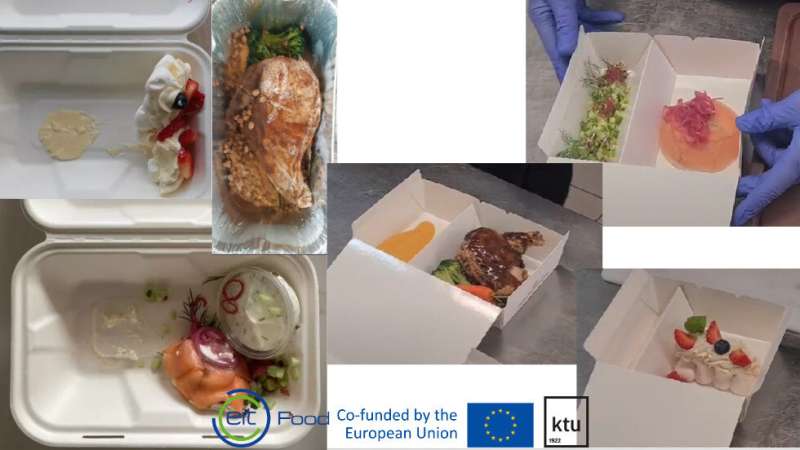Lithuanians develop a takeaway food package that's entirely plastic-free

Takeaway food has become an integral part of our lives. However, despite the convenience of such a service, frequent users have to face its drawbacks: the contents of the food can accidentally leak, the meal cools down, and the package does not always suit the size of the portion. Kaunas University of Technology researchers together with business and citizens created a takeaway food box, which solves all these issues and is entirely plastic-free.
"Kaunas citizens, with the help of professionals in their field and guided by scientists, are starting a real revolution in the world of takeaway food. Everyone can create innovations," says Aelita Zabulionė, a junior researcher at the Food Institute of Kaunas University of Technology (KTU), Lithuania.
During the laboratory session organized by the European Institute of Innovation and Technology Food community (EIT FOOD), ordinary citizens tried to discover the shortcomings of the currently used takeaway food packaging.
In the workshop, they were working together with packaging experts from the "Spaudos departamentas" and the representatives of a restaurant "Daugirdas" located in Kaunas, Lithuania.
During this session, the idea was born—to co-create solutions that would eliminate the shortcomings of ordinary takeaway packaging.
Citizens contributed to the creative process
The start of the project was a three-course dinner attended by a group of 16 people, whose ages ranged from 22 to 60 years. During the dinner, people evaluated the packaging of their food and shared their insights.
The plastic packaging used during the dinner perfectly reflected the typical shortcomings of takeaway food boxes. First of all, it was hard to adapt the package to a certain size. Secondly, the parts of the meal were not separated well enough from each other. Lastly, it was not clear how to dispose of the used package—wash it, recycle it, or throw it away with household waste.
During the dinner, the participants shared their experience that even after the simplest business lunch, an impressive pile of packaging remains in the office that later would end up in landfills for hundreds of years. Therefore, the most essential part of the project was the search for sustainable packaging materials.
The main complaint of the participants was the wrong temperature of the meal. Considering several food delivery companies operating in the city that use different transportation equipment, it was decided that it is almost impossible to expect to receive steaming hot food.
Therefore, participants of the project indicated the need to create a package in which food, prepared in a slow, nutrient-saving way, could be easily heated at home, without a need to transfer it from the package. For this, cardboard is the most suitable material.
Food in cardboard boxes can be heated in the oven
Cardboard can be recycled up to six times and after a certain processing method is applied, it is possible to compose a cardboard package that can withstand heating in the oven.
This type of cardboard is covered with a special non-flammable material, which takes up less than 10 percent of the weight. Moreover, the designed packages have specially adapted inserts—tabs which allow you to easily adjust the box size and separate the necessary components of food.
The boxes designed during the workshop come in three sizes, allowing for more economical and sustainable use of resources and making the packaging adaptable for different meals. To preserve the aesthetic appearance of the food during transportation, a special sleeve has been created—it holds the boxes in place, preventing them from rolling and moving around. The sleeve weighs less than a regular paper bag.
Per consumer request, clear instructions are printed on the packages which contain information on how they must be recycled, how long and at what temperature they can be heated.
"There is also a special supportive frame that prevents the lid from buckling and ruining the wonderful view of a restaurant's masterpiece—after all, we also eat with our eyes", says KTU researcher Zabulionė.
This innovation benefits not only the consumer but also the restaurant. The cardboard is perfectly suited for various types of printing—the restaurant logo or other important information can be displayed on the boxes.
Furthermore, the packages have been designed in such a way that when they are empty, they easily fit into each other and save storage space. After using the package, it can be sent for recycling or composted.
"Soon these boxes, created by Lithuanian consumers and businesses, will be one of the package options when ordering food at home," Zabulionė says.
Provided by Kaunas University of Technology





















